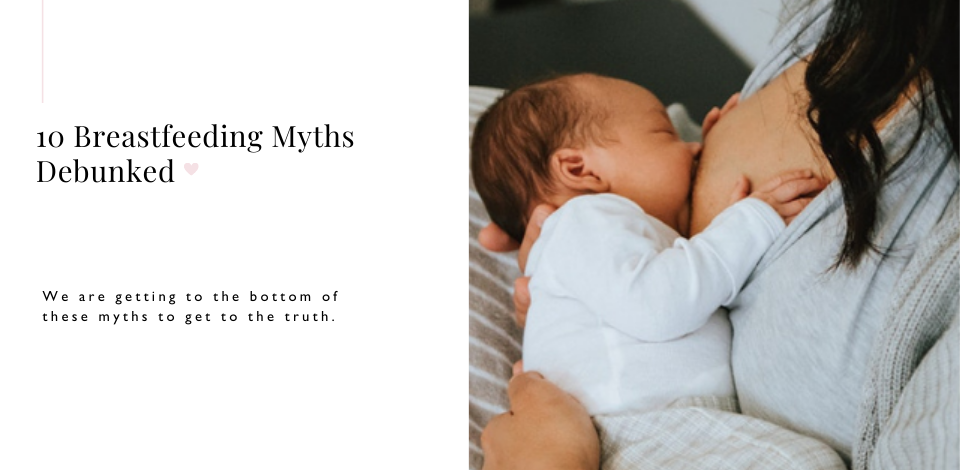10 Breastfeeding Myths Debunked
Jump to Section

New mothers often find themselves on the receiving end of all kinds of advice. Most people are genuinely trying to be helpful, but unfortunately, few topics attract more heated debate, misinformation, and confusion than breastfeeding.Many new moms who start breastfeeding find themselves hearing some of these “old wives' tales” and myths about breastfeeding that have no scientific basis or even logical justification. Far too often, you have to sift through a lot of breastfeeding misinformation in order to get the truth. That's why we partnered with Medela to get to the bottom of these myths and share some information that you may just find helpful!
Myth #1:
If You Have Small Breasts, You Won’t Produce Enough Milk to Feed Your Baby.
Size doesn’t matter! Whether you’re buxom or flat-chested, the size of your breasts has no impact on your body’s ability to produce milk.
Myth #2:
It Is Normal for Breastfeeding to Hurt.
While many women have some initial discomfort related to getting the baby to latch on to the nipple properly, breastfeeding is not supposed to be painful.
Myth #3:
A Mother Must Drink Milk to Make Milk.
Sorry milk lovers. This just isn’t true. Milk production is tied to how well the breast is being drained of breast milk.
Myth #4:
Breastfeeding Mothers Should Always Use Both Breasts at Each Feeding.
Your breasts “know” how much milk they need to make, depending on the baby’s demands.Myth #5:
Frequent Nursing Causes a Child to Be Obese Later in Life.
Health Canada
and has been shown to help reduce the risk of developing diabetes later in life.
Myth #6:
Nursing a Baby After 12 Months Is of Little Value Because the Quality of Breast Milk Begins to Decline After Six Months.
Breast milk doesn’t decline in quality over time.
It’s true that breast milk composition changes throughout the breastfeeding duration, but this is just another sign of how perfectly breast milk has developed to continue meeting your baby’s developing needs.
It’s important to remember that many of your baby’s systems will develop over years, not simply 6 or 12 months, which is why breast milk helps to continue to meet those developing requirements.
The reason we add complementary foods to breast milk at 6 months isn’t because breast milk is no longer important, it’s simply because your baby nutritional/caloric needs are no longer met by breast milk alone.
Your breast milk will continue to provide your baby immune protection, as well as nutrition, the entire time you continue providing your baby with breast milk. This is important because it takes years before a child’s immune system matures fully. Some parts won’t be fully developed until he’s over 10 years old!
Myth #7:
Don’t Breastfeed if You’re Sick
Breastfeeding is safe and healthy for babies, even if the mother is feeling under the weather.
In fact, part of the benefit of breastfeeding is that because your baby is likely exposed to the same cold or flu that you picked up, it’s easier for your mature immune system to develop the antibodies and leukocytes to fight the cold/flu than theirs.
These antibodies and leukocytes are transferred through your breast milk when you breastfeed.
Ingenious, isn’t it? The only exception is if you’re taking a medication that is not safe for breastfeeding mothers (always check with your doctor and pharmacist and make sure they know that you’re breastfeeding).
Check out this link for some advice from The Hospital for Sick Children on medications/alcohol and breastfeeding.
Flu viruses can be especially challenging on newborns, since their immune system is not yet mature. For this reason, it is best to make sure you have been vaccinated, as recommended by the Public Health Agency of Canada with the annual flu vaccine.
Remember, when you get vaccinated, your body will build the antibodies and leukocytes that will get transferred through your breast milk to your baby to help protect him from that virus.
Myth #8:
Breastfeeding Is a Fool-Proof Birth Control Method.
Breastfeeding can delay return of menstrual cycle and affect the levels of certain fertility hormones.
This seems to have been nature’s way of helping to ensure a safe spacing between children. However, breastfeeding is not a reliable birth control method. It is definitely still possible to get pregnant while you’re breastfeeding.
According to data from Planned Parenthood, about 2 out of 100 women who continuously breastfeed, will still become pregnant in the first six months. So if you aren’t ready to get pregnant again, consider using another form of birth control in addition to breastfeeding.
